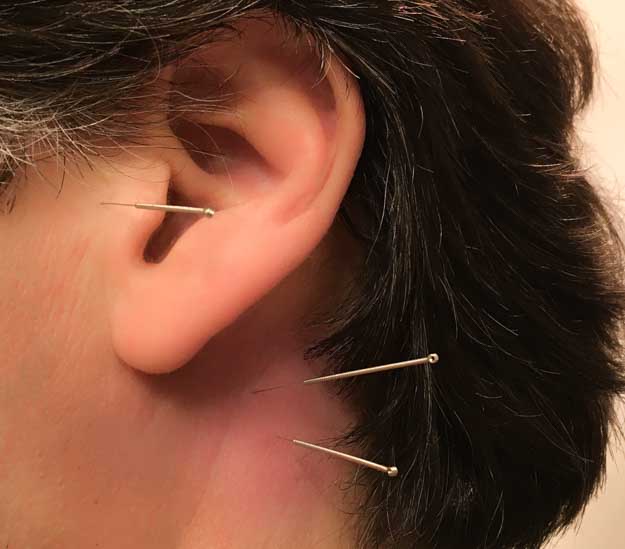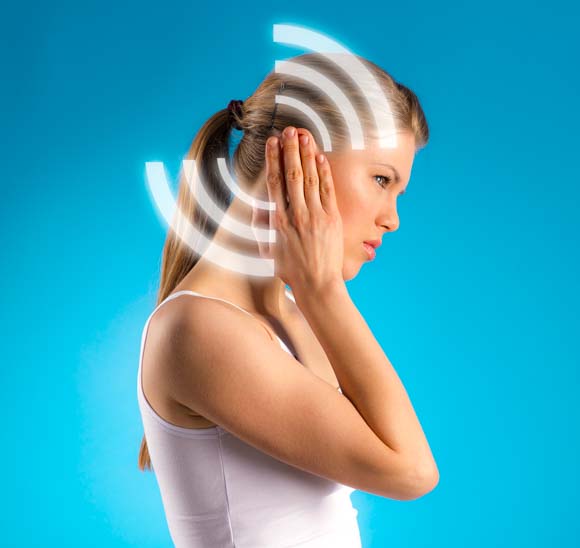Acupuncture alleviates tinnitus. Researchers from the Central Hospital of Otolaryngology and Head and Neck Surgery in Chaoyang City investigated the efficacy of acupuncture for the treatment of tinnitus associated with cervical disorders. The data demonstrates that one standard acupuncture point prescription is 50% effective and a specialized acupuncture point prescription has an 80% total effective rate. 
Cervical related tinnitus is ear ringing associated with instability of the craniocervical junction, intervertebral disc disorders, or other neck related pathologies (Montazem, 2000). This may involve temporomandibular joint dysfunction and stimulation of the somatosensory system (Shore et al., 2007). Cervical related tinnitus is a form of somatic tinnitus, which is due to head, neck, or dental disorders.
The research shows an enormous discrepancy between the efficaciousness of two acupuncture point prescriptions. The following acupoints resulted in an 80% total effective rate:
- Yiming (extra)
- Tianyou (SJ16)
- Fengchi (GB20)
- Wangu (GB12)
- Tinggong (SI19)
- Zhongzhu (KD15)
- Shangyang (LI1)
- Kunlun (BL60)
- Juegu (GB39)
- Ashi
The following set of acupuncture points only achieved a 50% total effective rate:
- Ermen (SJ21)
- Tinggong (SI19)
- Tinghui (GB2)
- Yifeng (SJ17)
- Zhongzhu (KD15)
- Xiaxi (GB43)
Two separate groups were tested with the acupuncture point prescriptions. Both groups had an acupuncture needle retention time of thirty minutes. Acupuncture was conducted once per day for a grand total of eighteen acupuncture treatments. The first set of acupuncture points outperformed the second set by 30% with a total effective rate of 80%.
Song et al. had similar findings in their research. Song et al. studied cases of intractable tinnitus treated with acupuncture and ginger moxibustion. The participants did not have cervical disorders as in Central Hospital of Otolaryngology and Head and Neck Surgery research. Physical examinations ruled out physical dysfunction of the auricle and middle ear, acoustic neuroma, sclerosis, head injuries, anemia, diabetes, hypothyroidism, hypoglycemia, autoimmune disease, and vascular spastic diseases. Patients with the aforementioned conditions were excluded from the study. 
The total effective rate was 91%. All patients had tinnitus for a duration between four months and eleven years. Acupuncture was applied to the following protocolized set of acupoints:
- TB17 (Yifeng)
- GB2 (Tinghui)
- SJ21 (Ermen)
- SI19 (Tinggong)
- LU7 (Lieque)
- GB43 (Xiaxi)
- SJ3 (Zhongzhu)
- LR3 (Taichong)
- GB40 (Qiuxu)
Acupuncture points TB17, GB2, and SJ21 were needled unilaterally on the affected side. If the tinnitus was unilateral, the patient rested on one side. For bilateral tinnitus, the patients rested in a supine position. Manual acupuncture stimulation was employed to elicit deqi. Electroacupuncture was applied to local ear acupoints using a continuous wave. Total needle retention time was 30 minutes. Acupuncture treatments were administered once per day for ten days.
Ginger moxibustion was applied along with the acupuncture point prescription. Ginger was sliced into 1 cm thick cubes, each with a small needle-punctured hole in the center. A mound of moxa was placed on the ginger and ignited. The ginger was placed on the outer auricle region.
A total of 64.17% patients fully recovered, 14.71% had significant improvements, 11.76% had slight improvements, and 8.82% had no improvements. The total effective rate was 91.18%. The researchers concluded that acupuncture combined with ginger moxibustion is effective for the treatment of intractable tinnitus. The researchers note that widespread adoption of this clinical treatment protocol is warranted based on the significant rate of positive patient outcomes.
References:
Montazem A. Secondary tinnitus as a symptom of instability of the upper cervical spine: operative management. Int Tinnitus J. 2000;6(2):130–133.
Shore S, Zhou J, Koehler S. Neural mechanisms underlying somatic tinnitus. Progress in brain research. 2007 Dec 31;166:107-548. University of Michigan, Ann Arbor, MI.
Xue H. (2015). Treatments of cervical tinnitus between neck acupoints acupuncture and traditional acupuncture. Jilin Journal of Traditional Chinese Medicine. 35(9).
Adams PF, Hendershot GE. (1999). Current estimates from the National Health Interview Survey, 1996. Vital Health Star10. 200: 81-103.
Zhu Y. (2005). Tinnitus epidemiological investigation in Northern Shaanxi. Journal of Disease Control. 12(6): 149-150.
Yingli Song, Li, Shilin, Yan Xiao, and Jiang Wu. "Efficacy Observation of Acupuncture Combined with Ginger Moxibustion to Treatment of 34 Cases of Intractable Tinnitus." Zhongyi Zhongyao (Traditional Chinese Medicine and Herbs) Aug. 2013: 277-278.


